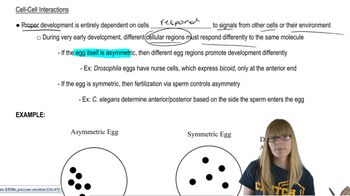Here are the essential concepts you must grasp in order to answer the question correctly.
Tumor Suppressor Genes and the RB1 Gene
Tumor suppressor genes like RB1 produce proteins that regulate cell growth and prevent cancer. The RB1 gene encodes a protein that controls the cell cycle, and mutations in RB1 can lead to loss of this control, promoting tumor development. Both copies of the gene typically need to be inactivated for cancer to occur.
Recommended video:
Knudson's Two-Hit Hypothesis
This hypothesis explains that two mutations ('hits') are required to inactivate both alleles of a tumor suppressor gene for cancer to develop. In hereditary retinoblastoma, one mutated allele (RB1⁻) is inherited, and a second somatic mutation inactivates the other allele, leading to tumor formation.
Recommended video:
Translation:Wobble Hypothesis
Genotype of Retinoblastoma Tumor Cells
In retinoblastoma tumor cells, both RB1 alleles are mutated or inactivated (RB1⁻/RB1⁻), resulting in loss of tumor suppressor function. Although the inherited mutation is dominant in predisposition, the tumor cells themselves are homozygous or functionally null for RB1, driving cancer progression.
Recommended video:
 Verified step by step guidance
Verified step by step guidance Verified video answer for a similar problem:
Verified video answer for a similar problem:

